| |
 |
|
Norton is a busy village
on the Stowmarket to Thetford road, but the
church is out in the fields. St Andrew is the
slightly demur sister church of St George, a mile
away at Stowlangtoft. A footpath across the
fields connects the two churches. Both are
treasure houses of the medieval, and both of them
bear the heavy hand of 19th century attempts to
make them appear more medieval than they already
were. Perhaps it is the more intimate scale of St
Andrew, and the way it is not so gloomy inside,
that makes me prefer it to its neighbour.
The church is open every day. You approach down a
narrow lane, and the church unfolds through an
avenue of trees in front of you. The graveyard is
wide and well-populated with 18th century
headstones, although there has been some
clearance to the south of the nave and chancel,
which is a pity. |
Even on this dull late winter day
in February 2018, the church felt full of light. This is
because of the size of the windows in what is actually a
small church, despite its aisles and clerestory. The
biggest are on the south side of the late 13th century
chancel, and were put in by the Victorians to match the
15th century ones in the nave. Some of this light is
coloured, because what Norton has in abundance is
fascinating stained glass.
One range in the south side of the
chancel has five almost complete early 15th century
figures. These include a superb St Christopher who I
think must have been touched up, a restored St Etheldreda
and St Andrew. A king with a cross may well be Henry V,
and another figure carries a martyr's palm. In the east
end of the south aisle there are four more figures, but
on closer inspection only the most southerly is anything
like complete. This shows St Agatha with a rather
gruesome breast in her pincers. Her head, you will see,
is a Victorian invention, as are the other three heads in
this range. At least hers is relatively appropriate - St
Paul, second from the left, has been given the head of a
young prince straight from Camelot. St Catherine has the
head of a medieval lady rather than a royal princess. The
figure of Christ blessing his mother from a Coronation of
the Blessed Virgin scene has been given the head of a
young girl. Is it possible that the restorer simply used
heads at random that were lying around in the workshop?
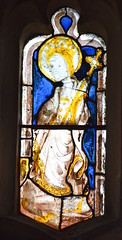 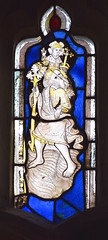  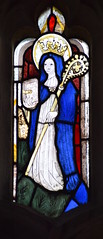    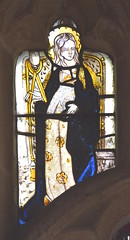
The stained glass in the chancel is
even more curious. The east window tracery dates from
that time in the 14th century when Decorated is becoming
Perpendicular. Mortlock thinks it is original tracery. It
has a cluster of late 19th century glass in the upper
lights depicting angels over St Elizabeth and the Blessed
Virgin. I assume that there was more below at one time,
but this has been removed. However, in a window above the
priests door that was retained during the Victorian
refurbishment, there is an angel swinging a censer above
his head.
And yet, he isn't. For the shape of this glass appears to
match exactly the tracery to the south and north of the
upper lights of the east window. He must have come from
here originally. The only problem is, to fit the glass in
you would need to turn him on his head, so that he is
upside down. This presents a rather more dramatic
prospect. Perhaps he was an angel of the Holy Blood
hovering above a crucifixion, a remarkable thought.

Norton church has two further
outstanding treasures of national importance. The first
is the 15th century font. It is in superb condition, and
I believe there is a good reason for this. The carved
reliefs are in heavily rebated niches, so that when the
Elizabethans plastered it over there was nothing
protruding to be mutilated. Virtually all that has
suffered is the tip of St Matthew's nose. Other faces
show the other three evangelists, and there are also a
pelican in her piety and a unicorn - a most unusual
subject on a font, but a symbol in various ways of both
Christ and the Virgin Mary. There is another on the font
across the fields at Pakenham.
Beneath the bowl are angels and Marian hearts, and
beneath them the supporters include a wodewose and a very
strange looking goat. It might be connected with the
heraldic symbol of the Bardwell family, who were Lords of
the manor here at the time of the rebuilding. Their
shield is also in the north aisle.
   
But what makes Norton
a really special place to visit is the collection of 14th
century stalls with misericord seats. They are some of
the finest in Suffolk, eclipsed only by those at
Stowlangtoft. This is, of course, interesting, if not a
little bit suspicious. Why should two neighbouring
churches have some of the best stalls in East Anglia? A
local carpenter who was good at them? Well, perhaps. But
I do not think the stalls originally came from either
church. They may have come from a priory church like
nearby Thetford, but they might also have come from Bury
Abbey, which had a connection with this church. However,
I am suspicious enough to wonder if either set were in
their current church before the mid-19th century. Not
that any of this matters, but it is a reminder to us
quite how achingly passionate the Victorians were about
restoring a sense of the medieval to their churches.
Where did they come from? The woman carding wool seems to
me a key East Anglian image of the time, and the monk
falling asleep over his manuscript a wry joke. The stall
end of a woman baring the bottom of the child beneath her
is rather more disturbing. At first it appears that she
is spanking him, but it is actually his hand on his
backside, not hers. Two other stall ends feature deadly
sins, a man with his money in a chest for avarice and a
man in bed for sloth. A lion savages a wodewose, a
pelican feeds her young with her own blood, St Edmund and
St Andrew are martyred. They are all superb.
 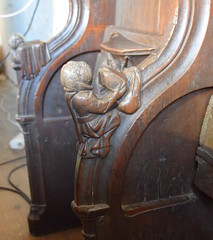 
 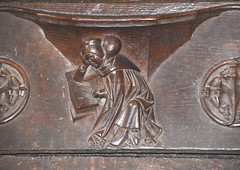 
  
Back in the nave there
are some very fine bench ends that clearly come from the
Stowlangtoft/Tostock/Woolpit group although most are very
badly mutilated. This is as likely to be wear and tear as
any form of iconoclasm, not least because the one
survival, and a surprising one, shows a priest telling
the rosary at his prayer desk. At the back of the church
is a very curious monument. The name has now gone, but
Mortlock tells us that it remembers Daniel Bales who died
in 1625. He left a dole of bread for the poor, and the
arched recess with the skeleton at the back was the place
where the bread was placed.
| At the time of the 1851
Census of Religious Worship, the minister here
was the splendidly named Reverend Aldersley
Dicken. Anglican congregations reached a peak in
the middle of the 19th Century, and even in
strongly non-conformist Suffolk one would
normally expect up to a third of the population
of the village to be attending the parish church
on a Sunday. However,
given Norton's 1851 population of 927 people,
Dicken was notably coy about the attendance at
his church, recording it on the census form as below
average congregation and 41 scholars. The
scholars, one assumes, had no choice but to
attend. Dicken then relented slightly, attempting
to define 'average congregation' as 117 in the
morning and 234 in the afternoon, but went on to
note that the church being at a distance from
the village, number present is subject to
accidents and could lead to no true conclusion.
One can't help thinking that the
census-numerators might have considered
themselves entirely capable of drawing any true
conclusions without Dicken's direction.
Meanwhile, up on the village high street 200
people attended worship in the Baptist Chapel,
and a brave and faithful 16 saw out the service
in the Wesleyan Reform Methodist Chapel.
|
|
 |
|
 |
|
|

